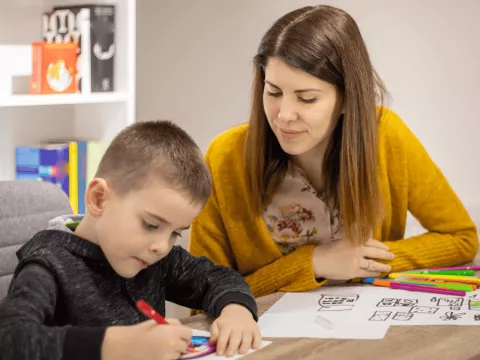- AdventHealth

Choose the health content that’s right for you, and get it delivered right in your inbox.
With obstructive sleep apnea, finding the right treatment solution for you is key to getting a good night’s rest. A continuous positive airway pressure (CPAP) machine is a standard treatment, but it’s not for everyone.
Inspire® Upper Airway Stimulation Therapy is a great option for people living with sleep apnea who haven’t found CPAP to be effective. We sat down with Andrew Agnew, DO, an ear, nose and throat (ENT) specialist at AdventHealth Tampa, to better understand how Inspire works and to get answers to frequently asked questions about this solution.
Obstructive Sleep Apnea 101
Obstructive sleep apnea is a sleep disorder that causes a blockage in your airways during the night. When your airways close, your brain wakes up — and that means your sleep is continually interrupted. Waking up tired and feeling less alert can throw a wrench in your day. And when you experience that feeling day after day, it can keep you from living your best life.
Left untreated, obstructive sleep apnea can lead to other health conditions too, including severe heart risks. But the good news is that Inspire can help.
What Is Inspire?
“Inspire is a treatment option that uses nerve stimulation to open your airways, so you breathe, and therefore sleep, better,” Dr. Agnew explains. The U.S. Food and Drug Administration (FDA) approved Inspire in 2014. And it’s currently the only approved treatment targeting obstructive sleep apnea's root cause.
How Does Inspire Work?
Inspire is a small device that gets implanted inside your upper chest. “It’s completely under the skin and controlled with a handheld remote, which means there’s no mask or hose to wear at night,” says Dr. Agnew. All you need to do is turn it on with the remote when you’re ready to sleep.
“You can think of Inspire kind of like a pacemaker for the tongue,” Dr. Agnew explains. Connecting to the nerve that controls your tongue movement, the device senses every time you take a breath. When you breathe in, it moves your tongue forward, so it doesn’t block your airway.
Lara Wittine, MD, FCCP, a pulmonologist and sleep medicine physician at AdventHealth Tampa's Sleep Medicine Center, shares insights about how the center's new Inspire obstructive sleep apnea treatment works in this short video.
Who Qualifies for Inspire?
“At AdventHealth, we have Inspire-trained doctors who help determine if it’s the right treatment option for you,” says Dr. Agnew. In general, four main criteria qualify adults (people ages 18 and older) for Inspire. We think of them as ABCD:

It’s important to note there are different types of sleep apnea. The Inspire procedure is only effective for patients with obstructive sleep apnea since it addresses the mechanical obstruction caused by the tongue. Patients with central sleep apnea, which is caused when the brain doesn’t send the correct messages to the muscles that control breathing, don’t qualify.
What Can I Expect During Inspire Surgery?
The Inspire procedure is performed as an outpatient procedure, which means you’ll go home the same day as your surgery. “You’ll receive general anesthesia and shouldn’t feel anything during the procedure,” says Dr. Agnew.
We’ll make two small incisions — one in your neck and one just below your collarbone in the chest — so we can insert:
- The Inspire device, which is about 4x6” in size and goes directly in your chest
- A respiratory lead, which senses when you inhale
- A sensory lead that attaches to your tongue and moves it forward
You can expect to stay at the outpatient facility for two to three hours before you can go home.
How Long Is the Recovery After Inspire Surgery?
Most people who receive the Inspire device recover quickly. While there can be some soreness and swelling, many patients find relief by taking pain medicine for a few days. And they get back to normal activities within a few weeks.
“You won’t use the Inspire device right away. About 30 days after your procedure, you’ll come back to see us. We’ll turn on the Inspire device using the remote and figure out the best settings for you,” Dr. Agnew explains. You’ll test these settings for the next few months to find the lowest effective power that works for you. Then, you’ll have another sleep test about 90 days after your initial procedure. “We’ll confirm that you’re happy with Inspire, and it’s working like it should,” Dr. Agnew says.
After that, you’ll do a follow-up visit one or two times each year. The battery life of the device is about 11 years. So, when you need yours replaced, you’ll come in for another procedure. But this procedure is less involved than the first one. Your doctor will make one incision to replace your Inspire device but keep the leads where they are.
Are Most People Happy With Inspire?
An overwhelming majority of Inspire patients say it’s better than CPAP, and that they would recommend it to others. Even better, most find that Inspire doesn’t get in the way of day-to-day life, Dr. Agnew affirms.
How Much Does Inspire Cost?
Most major insurance providers cover the Inspire procedure. But please confirm with your doctor and insurance provider beforehand to see if you’ll have to pay any out-of-pocket costs.
We’re Here to Help You Get Your Zzzs
If you’re facing ongoing sleep challenges, our ENT experts like Dr. Agnew and sleep medicine physicians like Dr. Wittine are ready to help you get the sleep of your dreams. From comprehensive sleep studies at our comfortable and modern sleep center to leading-edge treatments, we have you covered.
Visit us here to get more information and to schedule an appointment.


